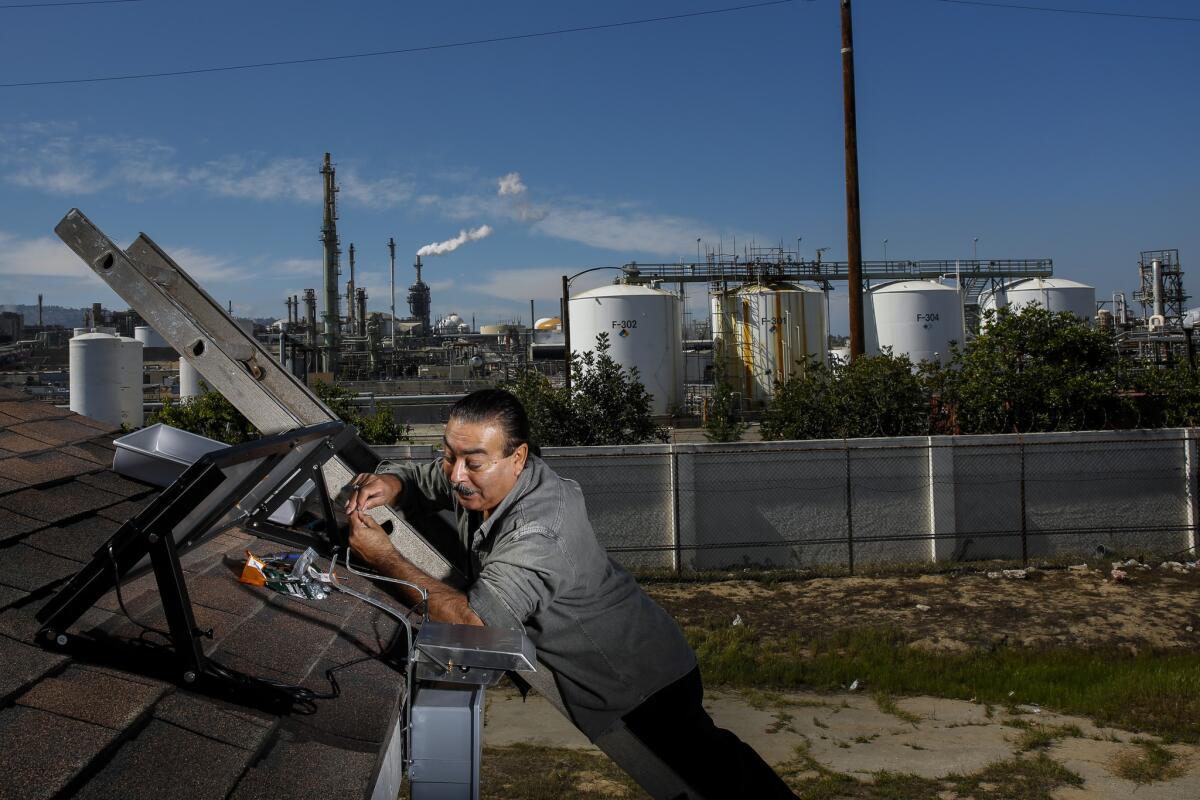EPA adopts rules to limit oil refineries’ emissions into neighborhoods

Jesse Marquez, executive director of Coalition for a Safe Environment, installs an pollution-monitoring device on a Wilmington home near the Phillips 66 oil refinery.
- Share via
The U.S. Environmental Protection Agency adopted new rules Tuesday intended to clean the air around oil refineries across the nation, including communities near six major refineries in Southern California.
The rules for the first time require refineries to monitor and report levels of benzene, a cancer-causing compound, at the boundaries of their properties and to cut emissions if they are too high.
The rules target about 150 oil refineries across the nation, strengthening standards on storage tanks, coker units, pressure relief devices and flares, which burn off excess gases. The measures are designed to reduce emissions that cause respiratory illness, increase cancer risk and contribute to smog and global warming while making refinery operations more efficient, the EPA said.
Refineries will have to encircle their facilities with one to two dozen canisters that continuously sample the air for benzene, a carcinogen that is considered an indicator of other harmful pollutants.
The so-called fence-line monitoring devices will not provide real-time air quality readings, but if benzene concentrations over time exceed the EPA’s limit of 9 micrograms per cubic meter, refiners will have to find the pollution source and fix it.
“This rule creates a kind of neighborhood watch for refinery pollution,” EPA Administrator Gina McCarthy said in a conference call with reporters. “Refineries can be held accountable for these fugitive emissions and take actions to stop them.”
The EPA was required to issue the long-delayed rules under a court-ordered consent decree with environmentalists and community groups in California, Louisiana and Texas, who sued the agency in 2012 for missing deadlines.
The rules drew praise Tuesday from those groups as bringing health benefits to predominately Latino and African American communities near oil refineries that have long fought for stricter regulations to control pollution, noise and smoke from the sprawling operations.
“Communities should finally start to see reductions in the pollution that refinery flares are releasing around the clock into our air,” said Jesse Marquez, who heads the group Coalition for a Safe Environment in the Los Angeles neighborhood of Wilmington, where three major refineries operate.
More than 6 million people live within three miles of a refinery, according to the EPA, with minorities nearly twice as likely as the general population to live near the fence line.
In a statement Tuesday, the American Petroleum Institute said refinery air emissions were already at safe levels and have been declining for decades under existing regulations.
“Companies have already spent billions of dollars to reduce emissions, and air quality continues to improve as a result of these voluntary programs and existing regulations,” said Bob Greco, API’s downstream group director.
While the EPA has made substantial improvements since proposing the new standards last year, the API said, the regulations could cost up to $1 billion.
The EPA said implementing the rules by 2018 will cost $283 million, with “no noticeable impact” on the cost of gasoline and other petroleum products. Cutting emissions of toxic air contaminants, including benzene, toluene and xylene, by 5,200 tons per year will reduce cancer risks for more than 1.4 million people, the agency said.
The South Coast Air Quality Management District does not currently require monitoring at the fence lines of the Los Angeles Basin’s six major oil refineries in El Segundo, Torrance, Carson and Wilmington, spokesman Sam Atwood said.
Southern California activists have long demanded fence-line air monitoring because of the large number of families, schoolchildren and other sensitive groups that live in close proximity to refineries and their emissions.
“Southern California is one of the few places in the country where you see daycare centers at the fence line and that’s why we pushed really hard,” said Jane Williams, who heads California Communities Against Toxics, another group that sued the EPA to issue the new standards. “This is a precedent-setting rule that we fought to get.”
For more news on air quality and the environment, follow @tonybarboza
More to Read
Sign up for Essential California
The most important California stories and recommendations in your inbox every morning.
You may occasionally receive promotional content from the Los Angeles Times.












